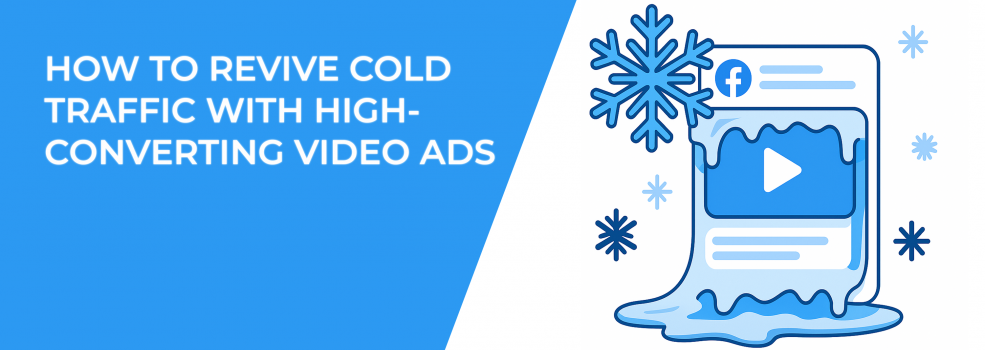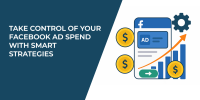Cold traffic is challenging. You're reaching an audience that doesn't know your brand, hasn’t interacted with your content, and likely isn’t ready to convert — yet. But the real issue isn’t necessarily the audience. Often, it’s the approach.
In 2025, Facebook's algorithm doesn't just analyze clicks and demographics. It's built to interpret behavior: how users interact with content, how long they watch, what they scroll past, and what holds their attention. In that environment, video isn’t just engaging — it’s essential. But simply producing a video won’t turn performance around.
To move cold audiences, your video ads must be structured, intentional, and strategically aligned with your objectives. Done correctly, they can drive significant results — even with viewers encountering your brand for the first time.
Let’s explore how to craft Facebook video ads that not only engage but guide cold traffic toward conversion.
Cold traffic isn’t hopeless — it’s untapped potential
It’s easy to see cold traffic as low-value. But this audience isn’t unqualified, they’re unfamiliar. They haven’t had a meaningful interaction with your brand yet, and that’s a key distinction.
Most Facebook and Instagram users aren't actively shopping when they encounter ads. They’re browsing for entertainment, news, or connection. That doesn’t mean they’re unwilling to engage — it means your ad has to offer something compelling enough to interrupt their scroll.
Instead of pushing for a sale immediately, focus on sparking interest. Your first goal is not conversion — it’s recognition. A well-executed video can introduce your brand, establish relevance, and create the first touchpoint in a much longer journey.
If you're not confident that you're targeting the right audience from the beginning, this foundational Facebook Ad Targeting 101 guide can help you refine your strategy before you ever hit “publish”.
The first few seconds matter more than you think
On Facebook, video ads autoplay silently, and you often have less than three seconds to capture attention. That’s why your opening moments are critical.
This is where your hook comes in — a powerful visual or message that stops the scroll and invites the viewer to stay. Avoid brand logos, intros, or explanations right away. Start with something unexpected or emotionally resonant.
Here are several techniques that perform well:
-
Pattern interruption: use a visual or motion that disrupts expectations — a zoomed-in object, an unusual action, or a jump cut can work well.
-
Thought-provoking questions: for example, “Why do most people fail at [X]?” or “Have you been making this mistake for years?”
-
Relatable scenarios: begin with a moment your audience recognizes, especially if it highlights a common frustration or challenge.
Since many viewers won’t hear the audio, ensure your message is also clear through visuals and on-screen text. Bold, animated captions can help drive your message even when sound is off.
Your video doesn’t need to feel like an ad. It should feel like a conversation worth pausing for.
Tell a story, don’t deliver a pitch
Once you’ve earned initial attention, your job is to keep the viewer engaged. This requires more than listing product features — it demands a narrative structure.
Effective video ads follow a flow that reflects how people think and feel when evaluating new information:
-
Hook — a visually or emotionally engaging start.
-
Problem — something your viewer relates to or struggles with.
-
Solution — your product or service introduced as a natural next step.
-
Proof — visual demonstration, customer testimonials, or key outcomes.
-
Call to action — clear guidance on what to do next.
Aim to make your story concise but informative. If you're targeting cold audiences, stay under 60 seconds whenever possible. In many cases, 20–30 seconds is optimal.
Use clear, conversational language. Avoid industry jargon or overly polished scripts. The goal is authenticity and relatability — especially for those unfamiliar with your brand.
Above all, ensure your video can communicate without sound. Use expressive visuals, animated text, and subtitles to deliver your message clearly.
Retarget intelligently: don’t just repeat yourself
Once a viewer has watched even a portion of your video, they’re no longer truly “cold.” They’ve shown a level of interest — which you can now build on.
Retargeting is your opportunity to continue the conversation. But many advertisers make the mistake of simply showing the same video again. This approach creates fatigue and often leads to lower performance.
Instead, create a sequence of videos that follow a logical progression. For example:
-
If your first video highlighted a challenge, follow up with a solution-focused testimonial.
-
If the initial content introduced your brand, the next video might go deeper into features or use cases.
-
If a viewer made it through 75% of your video, consider a direct offer or time-sensitive incentive.
Use Facebook’s Custom Audiences to segment based on video watch percentages — such as 25%, 50%, and 75%. The further someone progresses through your video, the more qualified they become for tailored messaging.
Your retargeting strategy should feel like a personalized journey, not a repetitive broadcast. If you haven’t yet built your retargeting infrastructure, this step-by-step guide to Facebook retargeting walks you through the setup and best practices.
Align creatives with campaign objectives
Performance drops quickly when creative and campaign objectives don’t align.
For example, running a conversion campaign with a video designed purely for awareness can confuse both the algorithm and your audience. Similarly, if you’re optimizing for video views, don’t include hard-sell language or detailed pricing information — it’s premature.
Here’s how to match content with intent:
-
Awareness campaigns: use curiosity-driven content that encourages passive viewing and social engagement.
-
Traffic campaigns: focus on intrigue and value to encourage click-throughs.
-
Sales campaigns: provide specific benefits, user proof, and strong calls to action to drive direct action.
Yes, this often means producing multiple versions of a single concept. But the clarity this brings to your ad funnel can significantly lower costs and increase return on ad spend (ROAS).
If your video is trying to do everything at once, it’s likely doing none of it well. If you’re unclear which objective to choose, this breakdown of Meta campaign goals can steer you in the right direction.
Test your videos in action
Success with cold audiences rarely comes from a single, perfectly crafted video. It comes from testing, learning, and iterating quickly.
Here are the key variables to test:
-
Hooks: try multiple opening lines or visuals to determine what grabs attention.
-
Video lengths: A/B test shorter cuts against full versions — some audiences respond better to brevity.
-
Formats: compare face-to-camera videos, animations, testimonials, and product demos.
-
Calls to action: experiment with CTA phrasing and placement — early, mid-video, or at the end.
Key performance metrics to monitor include:
-
ThruPlay rate (for understanding engagement)
-
CTR (click-through rate — a sign of interest)
-
Cost per result (view, click, or conversion)
-
Relevance score and engagement metrics (likes, comments, shares)
Test with speed, not guesswork. Launch several creative variations in parallel, watch the early data, and move quickly to promote what works.
Your creative doesn’t need to be perfect — but it does need to be responsive to your audience’s behavior.
Final thoughts
Engaging cold traffic isn’t about magic tricks or viral content. It’s about understanding that these viewers are encountering your brand for the first time — and building a system that meets them where they are.
The best Facebook video ads for cold audiences don’t just advertise. They educate, entertain, and invite the viewer into a new conversation. They’re structured to build interest, not demand commitment.
So instead of trying to force conversions on a first impression, focus on starting strong, telling a coherent story, and following up with relevance.
Because once someone pays attention — even briefly — the door opens. And from there, everything becomes more achievable.

